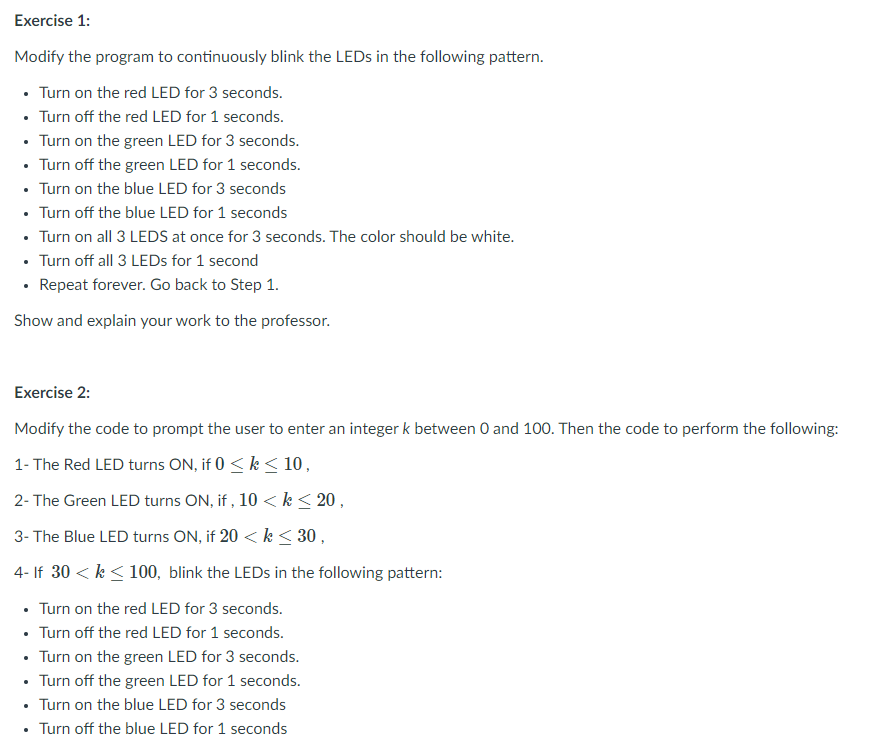Exercise 2: Modify the code to prompt the user to enter an integer k between 0 and 100. Then the code to perform the following: 1- The Red LED turns ON, if 0 < k< 10, 2- The Green LED turns ON, if , 10 < k < 20 , 3- The Blue LED turns ON, if 20 < k < 30 , 4- If 30 < k < 100, blink the LEDS in the following pattern: Turn on the red LED for 3 seconds. • Turn off the red LED for 1 seconds. • Turn on the green LED for 3 seconds. • Turn off the green LED for 1 seconds. • Turn on the blue LED for 3 seconds • Turn off the blue LED for 1 seconds
this code is in (.c) and I need help with what is in the image
I have already done part one and now need help with the second part
below is what I have so far
/*KL25Z_LED_Blinky.c*/
#include <stdint.h> /* provides fixed width integer types. For example, uint32_t) */
#include "derivative.h" /* KL25Z info */
#include "mcg.h" /* main clock generator */
#include "systick.h" /* SysTick timer */
#include "KL25Z_gpio.h" /* GPIO routines */
#include "KL25Z_port.h" /* PORT routines */
#include "delays.h" /* software based delays */
/* Macro definitions */
#define RED_LED_PIN 18 /* GPIO and PORT module "pins", not the device pins */
#define GREEN_LED_PIN 19
#define BLUE_LED_PIN 1
#define LED_OFF 1
#define LED_ON 0
/* Globals */
volatile uint32_t sysTicks; /* required for SysTick support. Do not delete. */
int main(void) {
/* Set of the main clock to run at 48 MHz and turn on SysTick
*
* The student should not make changes here unless instructed to do so.
*/
pll_init(8000000,0,1,4,24,1); // In mcg.c sets the main clock for 48 MHz
sysTicks = 0; // clear SysTick counter variable. Increments every millisecond.
initSysTicks(); // turns on SysTick interrupts and the count variable
/* Initialize the tri-color LED outputs in the PORT and GPIO peripherals
*
*/
/* turn on the PORT and GPIO module clocks */
enable_port_clock(PORTB_PERIPHERAL);
enable_port_clock(PORTD_PERIPHERAL);
/* set signal multiplexing for GPIOs to the LEDs */
set_port_mux(PORTB_PERIPHERAL, RED_LED_PIN, ALT1);
set_port_mux(PORTB_PERIPHERAL, GREEN_LED_PIN, ALT1);
set_port_mux(PORTD_PERIPHERAL, BLUE_LED_PIN, ALT1);
/* setup pin circuits. There are no pulldown resistors on a KL25Z */
disable_port_pin_high_drive(PORTB_PERIPHERAL, RED_LED_PIN);
disable_port_pin_filter(PORTB_PERIPHERAL, RED_LED_PIN);
select_port_pin_slow_slew(PORTB_PERIPHERAL, RED_LED_PIN);
disable_port_pin_pull_resistor(PORTB_PERIPHERAL, RED_LED_PIN);
disable_port_pin_high_drive(PORTB_PERIPHERAL, GREEN_LED_PIN);
disable_port_pin_filter(PORTB_PERIPHERAL, GREEN_LED_PIN);
select_port_pin_slow_slew(PORTB_PERIPHERAL, GREEN_LED_PIN);
disable_port_pin_pull_resistor(PORTB_PERIPHERAL, GREEN_LED_PIN);
disable_port_pin_high_drive(PORTD_PERIPHERAL, BLUE_LED_PIN);
disable_port_pin_filter(PORTD_PERIPHERAL, BLUE_LED_PIN);
select_port_pin_slow_slew(PORTD_PERIPHERAL, BLUE_LED_PIN);
disable_port_pin_pull_resistor(PORTD_PERIPHERAL, BLUE_LED_PIN);
/* setup the GPIO */
init_gpio_pin(GPIOB_PERIPHERAL, RED_LED_PIN, GPIO_OUT);
init_gpio_pin(GPIOB_PERIPHERAL, GREEN_LED_PIN, GPIO_OUT);
init_gpio_pin(GPIOD_PERIPHERAL, BLUE_LED_PIN, GPIO_OUT);
set_gpio_pin_level(GPIOB_PERIPHERAL, RED_LED_PIN, LED_OFF);
set_gpio_pin_level(GPIOB_PERIPHERAL, GREEN_LED_PIN, LED_OFF);
set_gpio_pin_level(GPIOD_PERIPHERAL, BLUE_LED_PIN, LED_OFF);
/* Main loop
*
*/
for(;;) { /* loop forever */
/* turn on and off the FRDM tri-color leds with GPIO function calls.
*/
set_gpio_pin_level(GPIOB_PERIPHERAL, RED_LED_PIN, LED_ON);
delay_sec(3);
set_gpio_pin_level(GPIOB_PERIPHERAL, RED_LED_PIN, LED_OFF);
delay_sec(1);
set_gpio_pin_level(GPIOB_PERIPHERAL, GREEN_LED_PIN, LED_ON);
delay_sec(3);
set_gpio_pin_level(GPIOB_PERIPHERAL, GREEN_LED_PIN, LED_OFF);
delay_sec(1);
set_gpio_pin_level(GPIOB_PERIPHERAL, BLUE_LED_PIN, LED_ON);
delay_sec(3);
set_gpio_pin_level(GPIOB_PERIPHERAL, BLUE_LED_PIN, LED_OFF);
delay_sec(1);
set_gpio_pin_level(GPIOB_PERIPHERAL, RED_LED_PIN, LED_ON);
set_gpio_pin_level(GPIOB_PERIPHERAL, GREEN_LED_PIN, LED_ON);
set_gpio_pin_level(GPIOD_PERIPHERAL, BLUE_LED_PIN, LED_ON);
delay_sec(3);
set_gpio_pin_level(GPIOB_PERIPHERAL, RED_LED_PIN, LED_OFF);
set_gpio_pin_level(GPIOB_PERIPHERAL, GREEN_LED_PIN, LED_OFF);
set_gpio_pin_level(GPIOD_PERIPHERAL, BLUE_LED_PIN, LED_OFF);
delay_sec(1);
}
return 0;
}

Step by step
Solved in 3 steps with 3 images


